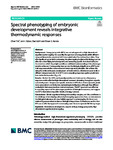Spectral phenotyping of embryonic development reveals integrative thermodynamic responses
| dc.contributor.author | Feistel, Susanne | |
| dc.contributor.author | Spicer, John | |
| dc.contributor.author | Ibbini, Z | |
| dc.contributor.author | Rundle, Simon | |
| dc.date.accessioned | 2021-05-10T18:46:48Z | |
| dc.date.available | 2021-05-10T18:46:48Z | |
| dc.date.issued | 2021-12 | |
| dc.identifier.issn | 1471-2105 | |
| dc.identifier.issn | 1471-2105 | |
| dc.identifier.other | 232 | |
| dc.identifier.uri | http://hdl.handle.net/10026.1/17110 | |
| dc.description.abstract |
<jats:title>Abstract</jats:title><jats:sec> <jats:title>Background</jats:title> <jats:p>Energy proxy traits (EPTs) are a novel approach to high dimensional organismal phenotyping that quantify the spectrum of energy levels within different temporal frequencies associated with mean pixel value fluctuations from video. They offer significant potential in addressing the phenotyping bottleneck in biology and are effective at identifying lethal endpoints and measuring specific functional traits, but the extent to which they might contribute additional understanding of the phenotype remains unknown. Consequently, here we test the biological significance of EPTs and their responses relative to fundamental thermodynamic principles. We achieve this using the entire embryonic development of <jats:italic>Radix balthica</jats:italic>, a freshwater pond snail, at different temperatures (20, 25 & 30 °C) and comparing responses against predictions from Arrhenius’ equation (Q<jats:sub>10</jats:sub> = 2).</jats:p> </jats:sec><jats:sec> <jats:title>Results</jats:title> <jats:p>We find that EPTs are thermally sensitive and their spectra of frequency response enable effective high-dimensional treatment clustering throughout organismal development. Temperature-specific deviation in EPTs from thermodynamic predictions were evident and indicative of physiological mitigation, although they differed markedly in their responses from manual measures. The EPT spectrum was effective in capturing aspects of the phenotype predictive of biological outcomes, and suggest that EPTs themselves may reflect levels of energy turnover.</jats:p> </jats:sec><jats:sec> <jats:title>Conclusions</jats:title> <jats:p>Whole-organismal biology is incredibly complex, and this contributes to the challenge of developing universal phenotyping approaches. Here, we demonstrate the biological relevance of a new holistic approach to phenotyping that is not constrained by preconceived notions of biological importance. Furthermore, we find that EPTs are an effective approach to measuring even the most dynamic life history stages.</jats:p> </jats:sec> | |
| dc.format.extent | 232- | |
| dc.format.medium | Electronic | |
| dc.language | en | |
| dc.language.iso | en | |
| dc.publisher | Springer Science and Business Media LLC | |
| dc.subject | Invertebrate development | |
| dc.subject | Aquatic embryo | |
| dc.subject | Energy proxy traits | |
| dc.subject | High dimensional organismal phenotyping | |
| dc.title | Spectral phenotyping of embryonic development reveals integrative thermodynamic responses | |
| dc.type | journal-article | |
| dc.type | Journal Article | |
| plymouth.author-url | https://www.webofscience.com/api/gateway?GWVersion=2&SrcApp=PARTNER_APP&SrcAuth=LinksAMR&KeyUT=WOS:000654888300001&DestLinkType=FullRecord&DestApp=ALL_WOS&UsrCustomerID=11bb513d99f797142bcfeffcc58ea008 | |
| plymouth.issue | 1 | |
| plymouth.volume | 22 | |
| plymouth.publication-status | Published | |
| plymouth.journal | BMC Bioinformatics | |
| dc.identifier.doi | 10.1186/s12859-021-04152-1 | |
| plymouth.organisational-group | /Plymouth | |
| plymouth.organisational-group | /Plymouth/Admin Group - REF | |
| plymouth.organisational-group | /Plymouth/Admin Group - REF/REF Admin Group - FoSE | |
| plymouth.organisational-group | /Plymouth/Faculty of Science and Engineering | |
| plymouth.organisational-group | /Plymouth/Faculty of Science and Engineering/School of Biological and Marine Sciences | |
| plymouth.organisational-group | /Plymouth/REF 2021 Researchers by UoA | |
| plymouth.organisational-group | /Plymouth/REF 2021 Researchers by UoA/UoA07 Earth Systems and Environmental Sciences | |
| plymouth.organisational-group | /Plymouth/Research Groups | |
| plymouth.organisational-group | /Plymouth/Research Groups/Marine Institute | |
| plymouth.organisational-group | /Plymouth/Users by role | |
| plymouth.organisational-group | /Plymouth/Users by role/Academics | |
| plymouth.organisational-group | /Plymouth/Users by role/Researchers in ResearchFish submission | |
| dc.publisher.place | England | |
| dcterms.dateAccepted | 2021-04-21 | |
| dc.rights.embargodate | 2021-5-15 | |
| dc.identifier.eissn | 1471-2105 | |
| dc.rights.embargoperiod | Not known | |
| rioxxterms.versionofrecord | 10.1186/s12859-021-04152-1 | |
| rioxxterms.licenseref.uri | http://www.rioxx.net/licenses/all-rights-reserved | |
| rioxxterms.licenseref.startdate | 2021-12 | |
| rioxxterms.type | Journal Article/Review |


